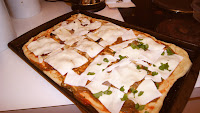
"The time is out of joint. O cursed spite that ever I was born to set it right." And so Hamlet laments the spectre of his father and his duty to avenge said father's death. Today, a different sort of ghost haunts us, whispering in our ears the wrongdoings of the food industry. Are we crazy? Or, like Hamlet, do we have some sort of duty to avenge the wrongs of the meat, dairy, and soy industries?
Let me back up to the first part of Hamlet's speech. The time is out of joint.
Here are some US statistics:
- In the 1970s, the top five beef packers controlled about 25% of the market. Today, the top four control more than 80% of the market.
- In the 1970s, there were thousands of slaughterhouses producing the majority of beef sold. Today, we have only 13.
- During the Bush administration, the head of the FDA was the former executive VP of the National Food Processors Association.
- During the Bush administration, the chief of staff at the USDA was the former chief lobbyist for the beef industry in Washington.
- In 1972, the FDA conducted 50,000 food safety inspections. In 2006, the FDA conducted only 9,164.
- In 1998, the USDA implemented microbial testing for salmonella and E. coli 0157h7 so that if a plant repeatedly failed these tests, the USDA could shut down the plant. After being taken to court by the meat and poultry associations, the USDA no longer has that power.
- In 1996 when it introduced Round-Up Ready Soybeans, Monsanto controlled only 2% of the U.S. soybean market. Now, over 90% of soybeans in the U.S. are Monsanto's genetically modified soy bean. (Prior to renaming itself an agribusiness company, Monsanto was a chemical company that produced, among other things, DDT and Agent Orange.)...oh yeah, Supreme Court justice Clarence Thomas was an attorney at Monsanto from 1976 to 1979. After his appointment to the Supreme Court, Justice Thomas wrote the majority opinion in a case that helped Monsanto enforce its seed patents.
- The average chicken farmer invests over $500,000 and makes only $18,000 a year.
- 70% of processed foods have some genetically modified ingredient.
- 1 in 3 Americans born after 2000 will contract early onset diabetes; Among minorities, the rate will be 1 in 2.
Time IS out of joint! Our practices are clearly not sustainable and may actually pose a threat to humans, animals, and planet earth in general.
Since I've been in the UK, I've noticed a rather unfortunate trend in vegan products: the vast majority of vegan products are soy-based.
SO, what does this mean?
soy is not very healthy for humans. it contains a lot of oestrogen, which can cause breast cancer in women or even early puberty in girls. In men its been linked to prostate cancer and even a low sperm count. Furthermore, as shown above, Monstanto pretty much controls soy production in the United States so that 90% of soy in genetically modified. The movie Food, Inc taught me that Monsanto can sue small farmers who keep their non-gmo seeds/do not use Monsanto seeds. Not only is soy production bad for the environment and our bodies, its bad for farmers. I thought that maybe soy in the UK-though bad for me- would at least be produced in a more sustainable, farm-friendly way. What I learned is that soy is flown in from either the US or South America. We already know what happens with soy in the US, but in South America large patches of rainforest are being burned in order to grow soy. Not very sustainable at all.
Just like in the US, a huge portion of the soy used in the UK goes towards feeding livestock. Animals like cows and chickens do not naturally eat soy, but its protein density makes it ideal for farmers who want hearty animals. We know its bad for us, is it healthy for animals? How much remains when we eat those animals or drink their milk?
The only non-soy beverages I can find come from this fabulous little grocery called Jorden Valley (I'll write about that another time though). Jordan Valley offers a wonder selection of rice milk, soy milk, oat milk, almond milk, and even hemp milk!!! However, all of these are produced in California and then somehow shipped over to Scotland. Not very local and probably not very good for the environment.
So I find myself in a tough situation. I've said it before and I'll say it again. I'm not a huge animal rights person, I don't like peta and I'm damn proud of a president who can kill a fly with his bare hand. I am vegan because of the environmental implications (exs: the meat packing industry emits more greenhouse gasses than all the cars, trucks, and airplanes in the world combined...soy production is now almost entirely genetically modified and big companies rarely allow farmers to let the land lie fallow for long enough be it with soy, corn, etc). If soy production is just as bad if not worse for the environment as dairy farms than I don't want to support the soy industry more than I have to. If my only soy alternatives come from thousands of miles away by plane I don't really want to support that either.
Here's the good news: rBGH is banned in the UK and organic farms still exist! Therefor, I have decided to renounce veganism while in the UK and opt for dairy products from locally grown organic farms. This is expensive...but not as expensive as the $7.00 USD hemp milk. Or the cost of breast cancer treatment.
If you want to know more about soy in the UK I highly recommend this 3 minute video:
I want to conclude with the second part of Hamlet's line: "O cursed spite that ever I was born to set it right." More and more evidence shows that we aren't crazy for thinking something is a-miss with the meat, dairy, and soy industries. I'm not asking anyone to become vegetarian...only to consider their options more and buy local, organic, non-gmo products when possible. Our food decisions don't only affect us- our choices affect the earth and all its creatures including plants, animals and our future generations. Setting it right doesn't have to be cursed, we can all make small decisions every day to make the world a safer and healthier place.
Cheers,Veg Girl












